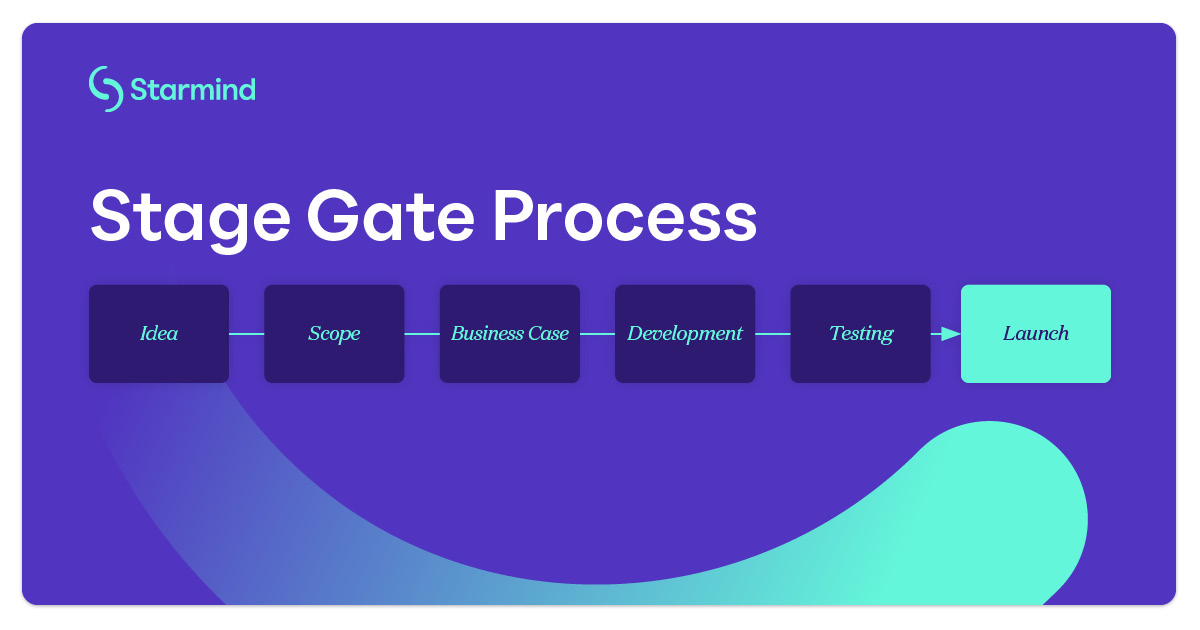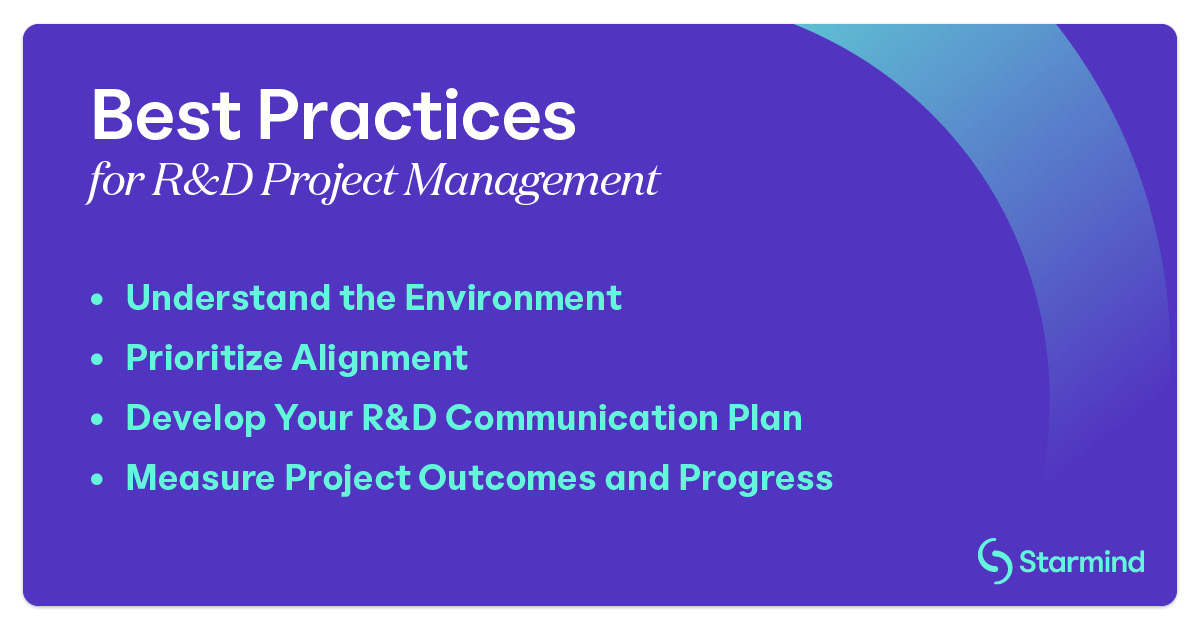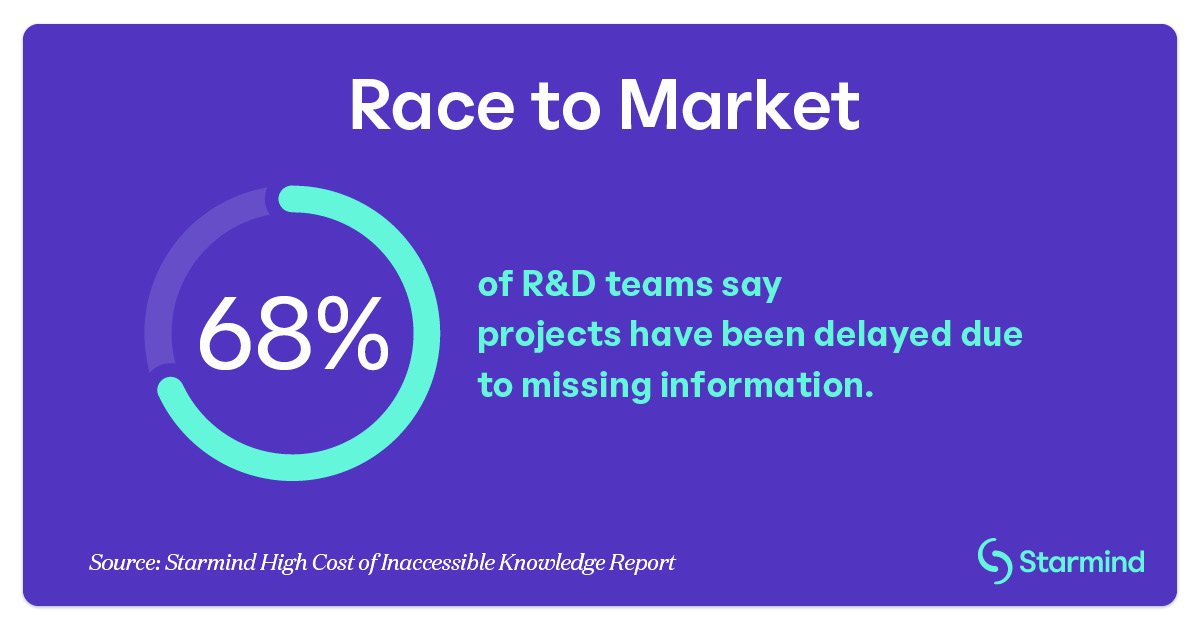Contents
Research and development teams thrive on a constant state of change, and R&D project management best practices are designed to adapt to this reality.
R&D project collaboration can be tremendously profitable, generating solutions that provide years of competitive advantage. However, the complex environment of R&D can stifle progress without careful planning and management.
Discover what makes project management unique for R&D, how to create opportunities for open communication, collaboration and knowledge transfer, and how to measure progress and results.
What Is R&D Project Management?
Project management is a process that helps teams complete a project or accomplish a goal while adhering to restrictions such as time, budget and scope. Traditional projects typically have defined limitations and predictable schedules. R&D is often less structured because testing, experimentation and uncertainty are essential aspects of the work.
Collaborative R&D projects can be some of the most difficult to plan and manage. Teams are responsible for creating new products and services that can’t be easily predicted, but schedules, milestones and costs are sometimes predetermined. In addition, executives and departments might have conflicting priorities, and major project updates or cancellations can occur at any phase. R&D teams are often scattered across locations, adding to communication and knowledge-sharing challenges.
The basic requirements for managing collaborative R&D projects include regular process reviews and communication with all stakeholders to address any concerns as quickly as possible. Project leaders must also align objectives with the organization’s overall strategy and ensure all participants can access the knowledge and resources they need to do their work.
 What Is the Stage-Gate Process for Product Development?
What Is the Stage-Gate Process for Product Development?
For R&D, control processes are critical for analyzing results and making adjustments throughout the project. Without regular review, project results will most likely be delayed or unsatisfactory, wasting time and resources for your teams and adding to total costs. Because of this, the stage-gate process can be the best fit for R&D projects in the enterprise. It follows these stages:
- Idea: Covers brainstorming activities, market research, and external input.
- Scope: Reviews a project’s viability through methods such as SWOT analysis.
- Business case: Includes supporting material, such as a project definition and plan, feasibility study or additional documentation or analysis.
- Development: Includes core design work for developing a prototype
- Testing: Recording and analyzing data from test scenarios, among other activities.
- Launch: Covers final product release and marketing and sales initiatives.
After each phase is completed, teams can review and determine whether the project needs improvements, can advance to the next phase or requires other action.
Is Collaborative R&D Effective?
The most obvious business case for R&D collaboration is achieving results more quickly. Collaboration can be so effective that even industry rivals will work together, choosing “coopetition” over pure competition. However collaboration occurs, it’s a productive method of sharing costs, resources and innovation results.
To realize the full potential of collaboration, teams must communicate and share knowledge and ideas easily. R&D teams benefit from a single source of knowledge that spans departments and functions. This enables your team to benefit from everyone’s efforts and insights without duplicating work or wasting time trying to answer questions that have already been resolved.
Collaboration also contributes to greater innovation, as unique perspectives can bring new and better solutions to problems. Instead of a small group of employees trying to solve problems within a silo, with only their knowledge to help them, R&D collaboration breaks down silos and allows many teams to share their unique perspectives, skills and expertise.
For example, your sales team has a closer working relationship with clients than anyone else in your organization. That direct relationship can provide unique and valuable insight into products and customers. A project that includes collaboration from sales, engineering and marketing will benefit from a broad perspective, as well as have three key functions championing the project’s outcomes.
Managing Collaborative R&D Projects
Managing collaborative R&D projects requires more agility and adaptability than traditional projects, but you should still begin with timelines and budgets. One advantage of joint projects is the ability to combine resources, which enables greater ambition, spreads out the burden and reduces individual risk.
The nature of R&D may mean that there’s little to no historical information for projections and deadlines. This makes it critical for R&D leaders to review progress regularly. Because timelines are difficult to predict, your tracking must be as accurate as possible so you can address any inconsistencies as early as possible.
Your R&D team may be lean, which places a greater emphasis on efficiency. Even cross-functional projects might not include representation from every part of your organization, so you’ll want to account for potentially missing knowledge or resources. Collaborative R&D requires you to maintain lines of communication that allow your team access to the information they need and create opportunities for other parties to contribute. This open access to knowledge allows your project to stay on track, which helps avoid project delays many organizations face.
How Does Modern Knowledge Management Improve R&D Collaboration in the Enterprise?
Innovation is born from collaboration and the sharing of knowledge and experiences. R&D cycles are accelerated when your team is empowered to communicate effectively, access existing knowledge and document their insights. While R&D projects are designed to break new ground, they still benefit from on-demand access to best practices and key findings from previous projects.
Each employee at your organization has unique knowledge and experience that can contribute to R&D success. A major challenge is identifying the tacit knowledge that needs to be shared, determining what team members have that knowledge and how to collect, retain and transfer it.
With a modern knowledge management strategy, your teams can share knowledge gathered across departments and locations, with a direct impact on reducing the time needed to develop solutions. Answers and information can quickly be provided when required. When there’s no documented solution, team members can connect with subject matter experts who can provide a resolution or additional information. This allows you to get to market faster, gain a first-mover advantage and reduce your R&D costs.
 4 R&D Project Management Best Practices
4 R&D Project Management Best Practices
Understand the Environment
Understanding the details and objectives of any project is important, but R&D operates in especially volatile and ever-changing environments. Regular analysis, maintenance and updates are essential. Expect challenges to arise at any stage.
When you understand the project environment, you can keep projects on task and track. You can respond quickly to unforeseen issues or poor initial results. To do this, you need a complete view of the project, including knowing where knowledge lives and who your subject matter experts can help.
A modern knowledge management system can create easy access to knowledge and experts without wasting time searching for the correct information or people. This allows R&D leaders to maintain close relationships with key stakeholders without micromanaging tasks.
Other considerations to keep in mind:
- Project goals and deadlines.
- Key milestones and dates.
- Team capacity and capabilities.
- Market conditions.
- Launch activities, such as marketing.
Prioritize Strategic Alignment
R&D projects and their goals should have clear links to your strategy. This will inform any potential changes to deadlines, budgets or focus as your project advances. Strategic alignment can ensure that decisions surrounding the project can be made from an informed perspective and will continue to drive the project toward its intended outcome.
Alignment also is important for the people involved. Your R&D team will contribute a variety of unique views, insights and motivations. Still, they should all be dedicated toward the overall vision and goals — not just of the project but also of the organization. Clearly communicate performance expectations, desired outcomes and how those help drive your business.
Develop Your R&D Communications Plan
Your communication plan should include when and how meetings will be structured, what communication methods are preferred and what technologies will be used, including project management or knowledge-sharing platforms.
Communication isn’t just about what’s said or written between people. Your team also needs easy access to the latest reports, historical data, and other documented information that could help. Knowledge management systems can help make all that information easy to find in one place.
These systems can also be where your team asks questions, seeks assistance and contributes their own knowledge. Ensure your knowledge management system empowers team members to ask anonymous questions. Otherwise, employees may hesitate to request assistance for fear of appearing incompetent.
Measure Project Outcomes And Progress
Measuring progress and results is a core function of R&D, but setting benchmarks and interpreting relevant data can be challenging. Many organizations have difficulty determining what’s most important, what to measure or how to use that data, especially in the early stages of projects.
Determine what metrics you’ll monitor and what data sources will help you draw conclusions about current performance and next steps. Metrics should tie back to the project’s scope and intended results. Any data analysis should help move the project toward the desired outcome. Decisions such as changes to budgets or timelines can also be discussed after reviewing key performance indicators and overall progress.
Progress should also be communicated regularly and be something team members can easily track on their own, such as through a dashboard.
 Accelerate Innovation With a Modern Knowledge Management System
Accelerate Innovation With a Modern Knowledge Management System
One of the biggest challenges in R&D is transferring tacit knowledge to other team members. Without an effective way to transfer knowledge, R&D teams can waste time searching for answers or information someone else on the team could easily share. Work is duplicated when teams unintentionally “reinvent the wheel,” and information can be lost in silos across the organization or when people leave. This results in longer innovation cycles, extra work and added expense.
With a knowledge management system like Starmind, you can leverage the power of artificial intelligence to reduce by 75% the amount of time R&D team members spend searching for answers. By creating a real-time knowledge network, your team can easily access knowledge, innovate faster, get new products to market quicker and seize first-mover advantages.
With careful planning, R&D project management best practices and a modern knowledge management strategy, you can achieve better results faster and at a lower cost.
Find out more about how you can drive innovation in your organization. Learn how knowledge management improves R&D efficiency and collaboration.



